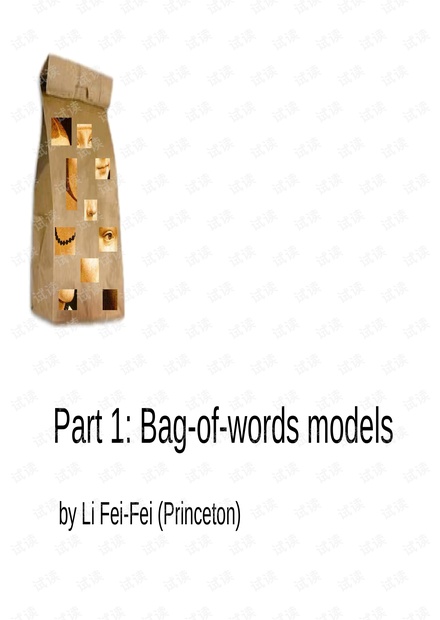没有合适的资源?快使用搜索试试~ 我知道了~
首页CVPR2007_tutorial_bag_of_words.ppt
CVPR2007_tutorial_bag_of_words.ppt
this is a ppt about image categorization from CVPR 2007
资源详情
资源评论
资源推荐

Part 1: Bag-of-words models
by Li Fei-Fei (Princeton)

Related works
Related works
•
Early “bag of words” models: mostly texture
recognition
–
Cula & Dana, 2001; Leung & Malik 2001; Mori, Belongie & Malik,
2001; Schmid 2001; Varma & Zisserman, 2002, 2003; Lazebnik,
Schmid & Ponce, 2003;
•
Hierarchical Bayesian models for documents
(pLSA, LDA, etc.)
–
Hoffman 1999; Blei, Ng & Jordan, 2004; Teh, Jordan, Beal &
Blei, 2004
•
Object categorization
–
Csurka, Bray, Dance & Fan, 2004; Sivic, Russell, Efros,
Freeman & Zisserman, 2005; Sudderth, Torralba, Freeman &
Willsky, 2005;
•
Natural scene categorization
–
Vogel & Schiele, 2004; Fei-Fei & Perona, 2005; Bosch,
Zisserman & Munoz, 2006

Object
Object
Bag of ‘words’
Bag of ‘words’

Analogy to documents
Analogy to documents
Of all the sensory impressions proceeding to
the brain, the visual experiences are the
dominant ones. Our perception of the world
around us is based essentially on the
messages that reach the brain from our eyes.
For a long time it was thought that the retinal
image was transmitted point by point to visual
centers in the brain; the cerebral cortex was
a movie screen, so to speak, upon which the
image in the eye was projected. Through the
discoveries of Hubel and Wiesel we now
know that behind the origin of the visual
perception in the brain there is a considerably
more complicated course of events. By
following the visual impulses along their path
to the various cell layers of the optical cortex,
Hubel and Wiesel have been able to
demonstrate that the message about the
image falling on the retina undergoes a step-
wise analysis in a system of nerve cells
stored in columns. In this system each cell
has its specific function and is responsible for
a specific detail in the pattern of the retinal
image.
sensory, brain,
visual, perception,
retinal, cerebral cortex,
eye, cell, optical
nerve, image
Hubel, Wiesel
China is forecasting a trade surplus of $90bn
(£51bn) to $100bn this year, a threefold
increase on 2004's $32bn. The Commerce
Ministry said the surplus would be created by
a predicted 30% jump in exports to $750bn,
compared with a 18% rise in imports to
$660bn. The figures are likely to further
annoy the US, which has long argued that
China's exports are unfairly helped by a
deliberately undervalued yuan. Beijing
agrees the surplus is too high, but says the
yuan is only one factor. Bank of China
governor Zhou Xiaochuan said the country
also needed to do more to boost domestic
demand so more goods stayed within the
country. China increased the value of the
yuan against the dollar by 2.1% in July and
permitted it to trade within a narrow band, but
the US wants the yuan to be allowed to trade
freely. However, Beijing has made it clear
that it will take its time and tread carefully
before allowing the yuan to rise further in
value.
China, trade,
surplus, commerce,
exports, imports, US,
yuan, bank, domestic,
foreign, increase,
trade, value

•
Looser definition
–
Independent features
A clarification: definition of “BoW”
剩余63页未读,继续阅读
shutingjingfeng
- 粉丝: 0
- 资源: 2
上传资源 快速赚钱
 我的内容管理
收起
我的内容管理
收起
 我的资源
快来上传第一个资源
我的资源
快来上传第一个资源
 我的收益 登录查看自己的收益
我的收益 登录查看自己的收益 我的积分
登录查看自己的积分
我的积分
登录查看自己的积分
 我的C币
登录后查看C币余额
我的C币
登录后查看C币余额
 我的收藏
我的收藏  我的下载
我的下载  下载帮助
下载帮助

会员权益专享
最新资源
- c++校园超市商品信息管理系统课程设计说明书(含源代码) (2).pdf
- 建筑供配电系统相关课件.pptx
- 企业管理规章制度及管理模式.doc
- vb打开摄像头.doc
- 云计算-可信计算中认证协议改进方案.pdf
- [详细完整版]单片机编程4.ppt
- c语言常用算法.pdf
- c++经典程序代码大全.pdf
- 单片机数字时钟资料.doc
- 11项目管理前沿1.0.pptx
- 基于ssm的“魅力”繁峙宣传网站的设计与实现论文.doc
- 智慧交通综合解决方案.pptx
- 建筑防潮设计-PowerPointPresentati.pptx
- SPC统计过程控制程序.pptx
- SPC统计方法基础知识.pptx
- MW全能培训汽轮机调节保安系统PPT教学课件.pptx
资源上传下载、课程学习等过程中有任何疑问或建议,欢迎提出宝贵意见哦~我们会及时处理!
点击此处反馈



安全验证
文档复制为VIP权益,开通VIP直接复制
 信息提交成功
信息提交成功
评论1